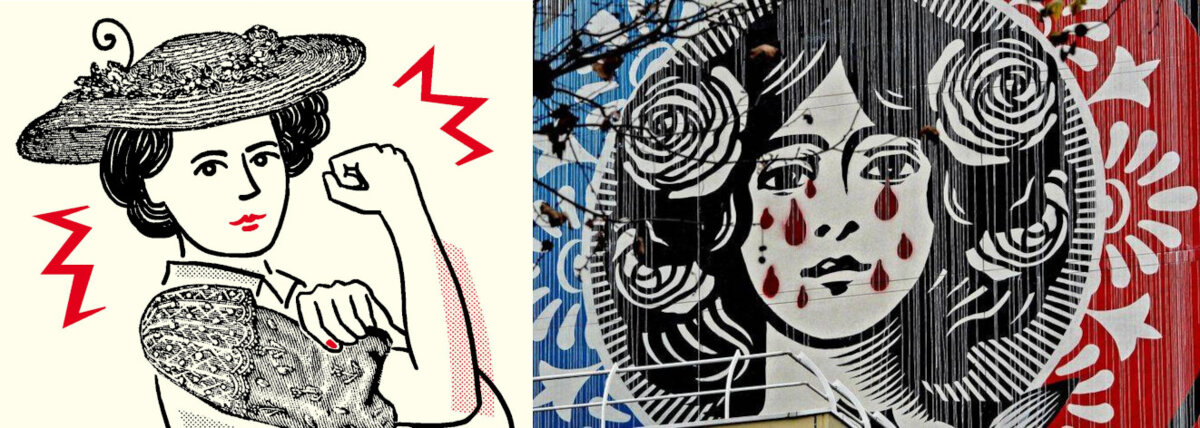France, like many other European countries, has been at great pains in recent years to tackle some of the systemic inequalities faced by women. Elisabeth Borne, the current prime minister, is the second woman in France’s history to hold the post, and the present speaker of the National Assembly is also a woman. Recent legislation has introduced progressive social measures, such as a quota of 40% of women in senior management positions in big business, an index of gender equality in higher education and the provision of reserved nursery places for single mothers seeking work. The French police and the prosecution services have been moving towards the proactive investigation of potential domestic abuse, even when an official complaint has not been made.

Agrandissement : Illustration 1

On the other hand, many French women feel that a reactionary and sometimes misogynistic current is taking hold in contemporary politics. They worry, for example, that the country is not immune to the reversals of abortion rights seen recently in countries like the United States, hence the successive attempts to enshrine the right to terminate a pregnancy in the French constitution. Salary inequality remains an issue and violence against women is still endemic. There were 122 reported femicides in France in 2021 and structural problems of sexual harassment and domestic abuse are being brought to light with increasing frequency in the French-language media. In the broader French-speaking world, the range of issues relating to women’s rights is extremely varied. This is especially true in former colonies, where the often suppressed history of sexual violence during the wars of independence and the period of decolonisation sometimes undermines attempts by the old colonial power to encourage the development of rights and support for women.
In short, women’s rights continue to advance on various fronts in the French-speaking world, but there is still quite some way to go, and several rights and support systems remain fragile or tenuous. Opinions also differ across the French media, with certain news outlets accused of allowing misogynistic commentators a platform, whereas others are attacked for being too pro-feminist.
The Blog
This blog, the eleventh journalism translation project by students of the MéLexTra JET master’s degree in English-French translation at the University of Lille, is aimed at readers of Mediapart English who wish to learn a little more about French media coverage of these issues. It seeks to tease out some of the cultural tensions and accommodations between conflicting concepts in the French media’s reporting of issues relating to women's rights, both locally and internationally.
Who are we?
Eight students completing their second year ‘JET’ master’s degrees (Traduction Juridique et Technique) specialising in legal and technical translation between French and English. This project is part of a module (Traduction journalistique) in which French journalism is translated into English. It is overseen and edited by the module’s teacher, applying a collaborative student-centred learning approach in the ‘newsroom class’.
Translators:
Maria BOU GHARIOS
Zénaïde ESSAMMAH
Sophie GARNIER
Fanny PISSELOUP
Olivia PRITCHARD
Julie RODHON
Gauthier SÉNÉCAL
Margot RACINE
Editor:
Sam TRAINOR
What sorts of articles are translated?
The project has two main goals. The first is to allow non-French readers to delve a little deeper into debates surrounding women's rights in the French-speaking world. The second is to provide readers with an idea of how local and global issues related to the broader topic are reported and discussed in the French press, and what this might reveal about the country’s news media.
Articles are taken from a wide variety of local, national and international French journalistic sources, appearing in print, broadcast and online. The project seeks, in part, to give non-French readers an insight into the various ideological leanings of the different sections of the French media and how these correlate (or not) with their positions regarding these issues. Articles will therefore be selected from sources with a broad spectrum of political leanings. An introductory ('standfirst') paragraph always provides some brief information on the source context.
Where can the original articles be found?
In every case, copyright and publishing details are provided in the translations: the original authors, photographers etc. are always indicated. Links are also provided to online versions of the original articles in their original publishing context, wherever possible.
What is our translation policy?
Translations are initially provided by pairs of students, one of which is the initial or lead translator. Following a 'strategic layering' approach, the other translator is responsible for sourcing and translating any quotations or other 'source level material' in the article, and the lead translator then adapts this material to his/her translation of the journalist's copy. These are sub-edited by the editorial team (the whole class) who also provide 'editorial level material' (like the headline, standfirst, notes etc.), and the article is then posted online. The article can potentially undergo a final modification by the editors of Mediapart English before being moved to the club section of the paper’s front page. Stylistically, the translations are relatively close to the originals and there is a little less structural or syntactic reorganisation involved than would be the case in more general journalistic practice. Articles are not therefore modified to suit English journalistic ‘news style’, for example. One of the key goals of the project is to give non-French readers an idea of how the issues are presented in the French media. French journalistic style is therefore preserved in the translations. For a related reason, a number of terms are left in French, with links to a glossary article being preferred to explanatory translations. These include, for example, terms for local geographical areas, like département, and titles of political offices, such as député and préfet.
What kind of English is used in MéLexTra blogs?
Mediapart being a European publication, British English spellings are used throughout, as are predominantly British English grammar and vocabulary. However, the French constitution and political context being closer in some circumstances to the language culture of the United States than the United Kingdom, there are a handful of globally recognisable American English idioms that have naturally been incorporated in previous projects. Presidential candidates, for example, are said to be ‘running for office’ rather than ‘standing for election’. This contextual hybridisation of English varieties is likely to continue with all future projects.
House style meets the "Translation Bible"
The French term "Bible de traduction" is a concept borrowed from professional audiovisual translation practice, where the subtitlers or dubbing authors of a television series establish and share a set of fixed translation solutions and equivalences for recurring terms which, for reasons of continuity, all collaborators are asked to follow. One of the main features of this annual translation project is the continual expansion and renewal of what might be considered an expanded house 'style guide', specifically adapted to the translation of politically inflected French news journalism in English. In the 'editorial classroom', students not only pitch, discuss and choose between articles for translation, mirroring the activity of a traditional newsroom, but they also discuss specific translation choices and the possibility of adding a new, potentially recurring translation solution as a conventional equivalence in the project's style guide.



